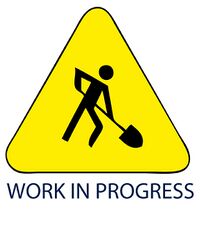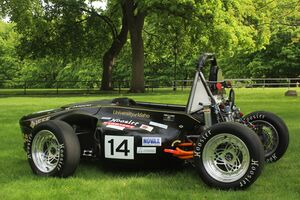Vandal Hybrid Racing
| Formula Hybrid Vehicle picture from 2014 | |
| Sponsors | |
| Team Name | Celeritas |
| Duration | Summer 2014 - Spring 2015 |
| Faculty Advisers | |
| Mentor | |
| Students |
|
The Vandal Hybrid Racing Team is a University organization that competes annually at the Formula Hybrid competition hosted by the Society of Automotive Engineers. This team gives students the opportunity to demonstrate and further develop their engineering skills by challenging them to build a hybrid formula car. Because of the complexity of a hybrid vehicle, building it involves interdisciplinary collaboration between students. For the 2015 competition, the team will be using the same frame that was used in the 2014 competition.
Problem Statement
Because the 2014 frame will be used in the 2015 competition, it is required that significant improvements must be made to the car. The team will strive to improve the car by redesigning problem components, reducing weight where possible, improving car handling, and increasing vehicle efficiency. This will produce a responsive, reliable, lightweight, high performance hybrid car.
Sub-System Problems and Improvements
Brake Rotors
ISSUES: Front and rear brake rotors are larger than needed; only a fraction of the available friction surface is being used. Also, rear brake rotors are susceptible to cracking due to insufficient heat dissipation of the thin slotted design SOLUTION:
- Redesign front and rear rotors, optimizing friction surface areas
- Float both the front and rear rotors to reduce weight
- Rear rotors will no longer be used for wheel speed sensor
Progress: design done, material needs to be attained or designs need to be ordered.
Rear Wheel Toe
ISSUE: The toe in the rear wheels has slop in it due to flexing and component bending. This causes significant toe movement on the track.
SOLUTION: Original solution was to shorten tie rods and add a holding bracket attached to the A-frame. Upon further investigation, we need to redesign/repackage the upright assembly so a new solution will be implemented according to the new upright design.
Uprights
ISSUE:
- upright assembly limits workable space for other assemblies
SOLUTION:
- Redesign upright assembly
- optimize for minimal weight and suspension assembly compatibility
Brake Master Cylinders
ISSUE:
- Brakes lock up after brakes get hot because built up pressure can not be properly alleviated from the high pressure line. Piston doesn't allow fluid to return to reservoir.
- Pedal assembly is heavier than we would like it
SOLUTION:
- Redesign piston mechanism
- Add a "catch clip" that will return the piston to an open position when no pressure is applied to the brakes
- Repackage pedal assembly to shed weight wherever possible
Progress: New Pistons are being manufactured, should be on the car before the end of summer term.
Aerodynamics
ISSUE: There are no components to optimize car aerodynamics
SOLUTION:
- Use CFD knowledge to design a functional underbelly diffuser
- Test model in wind tunnel
Progress: 2-D CFD simulations are being conducted. 3-D modelling for the diffuser will be started after 2-D simulations are analyzed.
Suspension
ISSUE:
- Suspension components could be made lighter
- Suspension system isn't operating as required by competition guidlines
- Suspension system needs to be tuned to improve handling
SOLUTION:
- Redesign or fix limited suspension travel
- Replace current components with lightweight carbon fiber components
- Tune suspension components on the track
Engine Tuning
ISSUES:
- Engine needs to be tuned and maintained at an optimal level
- Last engine lost compression and damaged crank
- Crankshaft had excessive endplay
- Crankshaft showed wear marks behind flywheel, consistent with excessive lateral movement.
- Connecting rod had excessive lateral endplay
The engine was dismantled to inspect components and replace any damaged components. While the engine was off of the car, we noticed the crankshaft had a shaft endplay of 0.0475". The stock engine case allows for 0.016" of endplay. To reduce the amount of endplay in our case, 0.020" shims were placed under the main bearings. This reduced measured endplay to about 0.009" and kept the connecting rod well centered in the cylinder. These shims should stop the crankshaft wearing behind the flywheel and should keep the connecting rod from developing excessive lateral endplay.
SOLUTIONS:
- fix crankshaft endplay with under-bearing shims
- Run tests on the dyno engine and use that data to tune the race engine.
- Maintain engine during driving/testing days.
Steering Angle Sensor
ISSUE:
- We currently have no way of logging steering angle data
SOLUTION:
- Design a sensor that can be used to log real time steering angle on the track
Progress: Design made, needs to be prototyped and tested.
Wheel Speed Sensors
ISSUE:Current wheel speed sensor system requires brake rotors for timing. Moving the sensor elsewhere will allow more freedom in rotor design.
SOLUTION:
- Use a thin slotted wheel mounted somewhere along driveline
Progress: NA
Battery Pack
ISSUE:
- Battery box could be redesigned and rebuilt with more flame resistant material
- Battery cell expansion is unknown
SOLUTION:
- Test battery cells for maximum expected expansion
- Analyze and redesign box according to test results
Finalized Sub-Systems
| SUB-SYSTEM | DESIGN SUMMARY | FINAL DESIGN |
|---|---|---|
| BRAKE ROTORS | ||
| WHEEL SPEED SENSOR | ||
| REAR WHEEL TOE | ||
| BRAKE SYSTEM | ||
| SUSPENSION | ||
| AERODYNAMICS | ||
| BATTERY PACK | ||
| STEERING ANGLE SENSOR |
Team Biographies
To be populated soon
Appendices
Documents
TBA

|
This article is under construction. WE NEED MEMBER PICTURES AND BIOS |
